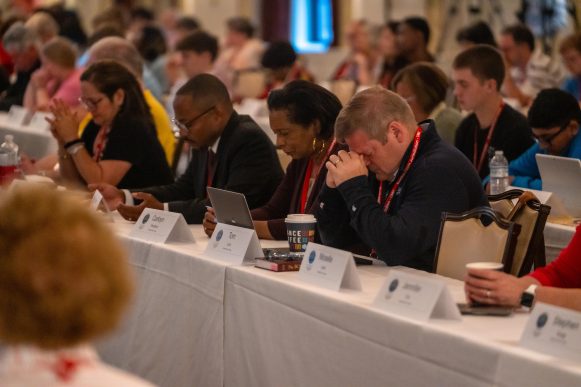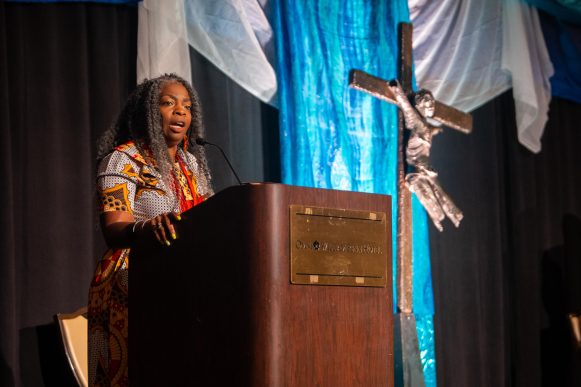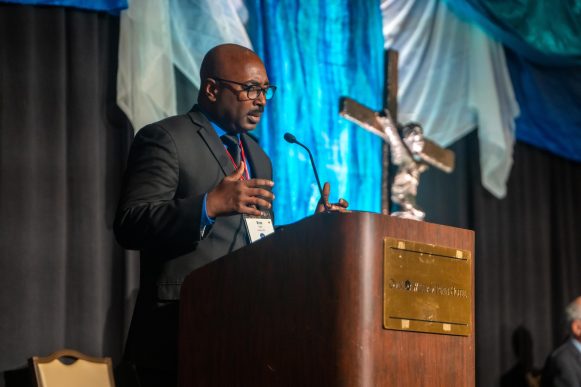Delegates explore history of structural racism in the Methodist church
In the space where episcopal elections would have taken place, delegates gathered for a holy conversation about race and the way that structural and systemic racism colors both our past and present. The city of Pittsburgh was an ideal place to have this sacred conversation. 60 years ago, Methodists gathered here for the 1964 General Conference, which came to discuss, among other business, how to move the church towards greater racial integration.
Bishop Peter Weaver, a retired bishop of the Northeastern Jurisdiction, told the story of that conference. He attended, not as a delegate, but as part of a group of students and clergy who had been working to integrate working to integrate churches in Jackson, Mississippi. The students of Tougaloo College, alongside their chaplain, Rev. Ed King, and others, organized a Pilgrimage to Pittsburgh to urge the church to address the structural racism and segregation perpetuated by the continued existence of the Central Jurisdiction.
Demonstrations outside the 1964 General Conference
More than 1,000 people gathered for an all-night vigil at the Smithfield Street Methodist Church. They brought with them a charred cross that had been burned by the KKK on the lawn of Rev. Ed King, the chaplain of Tougaloo college, who had been instrumental in the work towards racial integration.
After praying together through the night, protestors gathered outside the conference center. Bishop Weaver shared that those who participated in the protest prayed on their knees that “hearts would be changed, so that structures would change.” Protesters would later storm the floor of the General Conference to disrupt the proceedings and demand an immediate end to segregation by abolishing the Central Jurisdiction.
The Central Jurisdiction: A history of structural racism
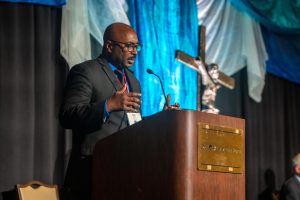 The Central Jurisdiction was created in the 1939 merger of the Methodist Episcopal Church, the Methodist Episcopal Church South, and the Methodist Protestant Church. The southern church only agreed to this union after a compromise to create a jurisdiction based on race, rather than geography.
The Central Jurisdiction was created in the 1939 merger of the Methodist Episcopal Church, the Methodist Episcopal Church South, and the Methodist Protestant Church. The southern church only agreed to this union after a compromise to create a jurisdiction based on race, rather than geography.
Eric Carr, chairperson of the Black Methodists for Church Renewal of the Northeastern Jurisdiction (NEJ BCMR) spoke of the history of the Central Jurisdiction. “The Creation of the central jurisdiction was meant to separate and divide,” he stated. “It is said to be Methodism’s original and central sin, whose residual effects are still visible and felt in the denomination today and most specifically in today’s Central Conferences.”
While the Civil Rights Act of 1964 would soon end segregation, Methodists at the 1964 General Conference would choose to maintain the status quo. Systemic and structural injustice was allowed to continue unchecked until the 1968 Uniting Conference, where the Evangelical United Brethren Church made abolishing the Central Jurisdiction a condition of the merger that formed The United Methodist Church.
A symbol Methodism’s racist past invites prayers of repentance
That same cross that was the central symbol of the 1964 demonstration stood on the stage as a focal point of the worship service. The body received the story and was invited to consider how the residue of systemic racism continues to affect us even today and reflect upon our complicity in perpetuating and participating these systems rather than working to dismantle them.
Delegates engaged in a litany of repentance that incorporated both the baptismal vow of all methodists to “reject evil, injustice and oppression, in whatever forms they present themselves” with Lift Every Voice and Sing, the Black National Anthem.
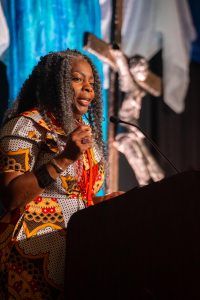 After time of collective confession and repentance, Bishop Cynthia Moore-Koikoi stood and concluded the service with a rousing charge, adapted from the work of Cole Arthur Riley, author of Black Litanies, and the book, This Here Flesh.
After time of collective confession and repentance, Bishop Cynthia Moore-Koikoi stood and concluded the service with a rousing charge, adapted from the work of Cole Arthur Riley, author of Black Litanies, and the book, This Here Flesh.
She called on every person present to honor their true selves and to hold fast to the commitments that they made today.
“Listen to the cries of those around you. And then follow a path of healing and liberation for yourself, but more importantly, for those around you and all you encounter. Take peace in the sound of your own voice, And the sound of the voice of God that you hear coming from others. And choose a life, a life that honors your true self, and the commitments that you have made today. May it be so. Amen.”
We tell the story of our racist past because the work is not yet finished. The residue of structural racism remains, and it continues to affect our life together. The liturgy of repentance that the delegates prayed is available for your use. It was written by the Rev. Amy Wagner in consultation and collaboration with the Rev. Eric Carr, chairperson of the NEJ BMCR. The second movement of this act of repentance names sinful action that has occurred at previous gatherings of the Northeastern Jurisdiction. Consider replacing it with an action that your congregation might need to confess.
Litany of Repentance by Rev. Amy Wagner

